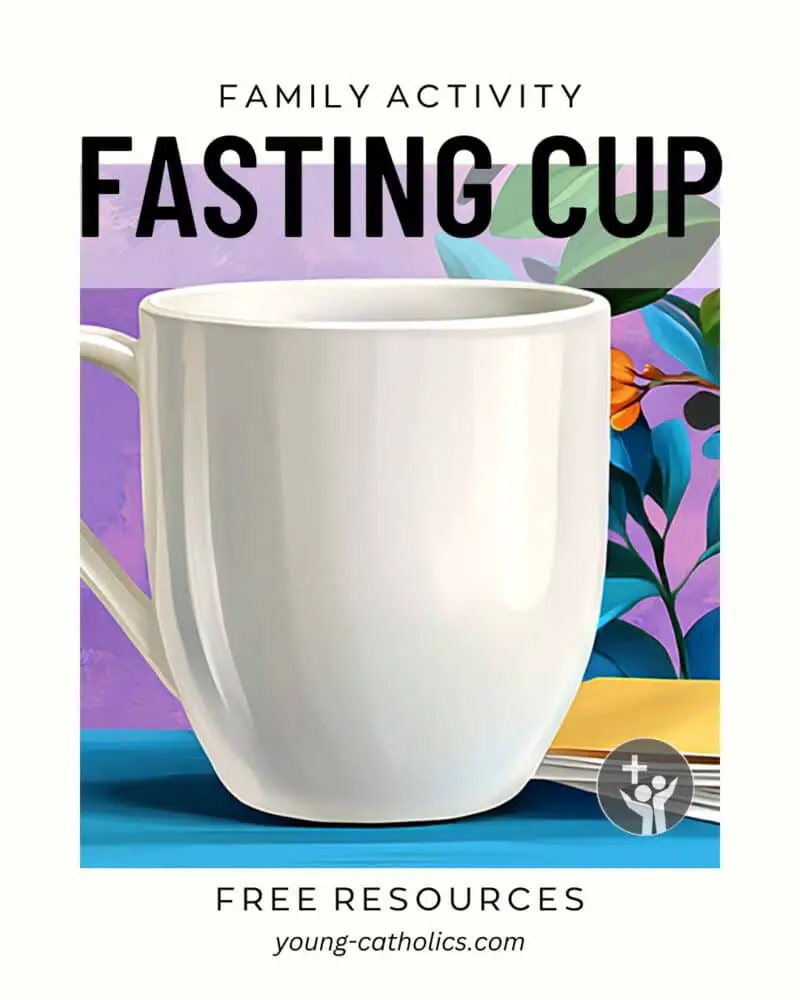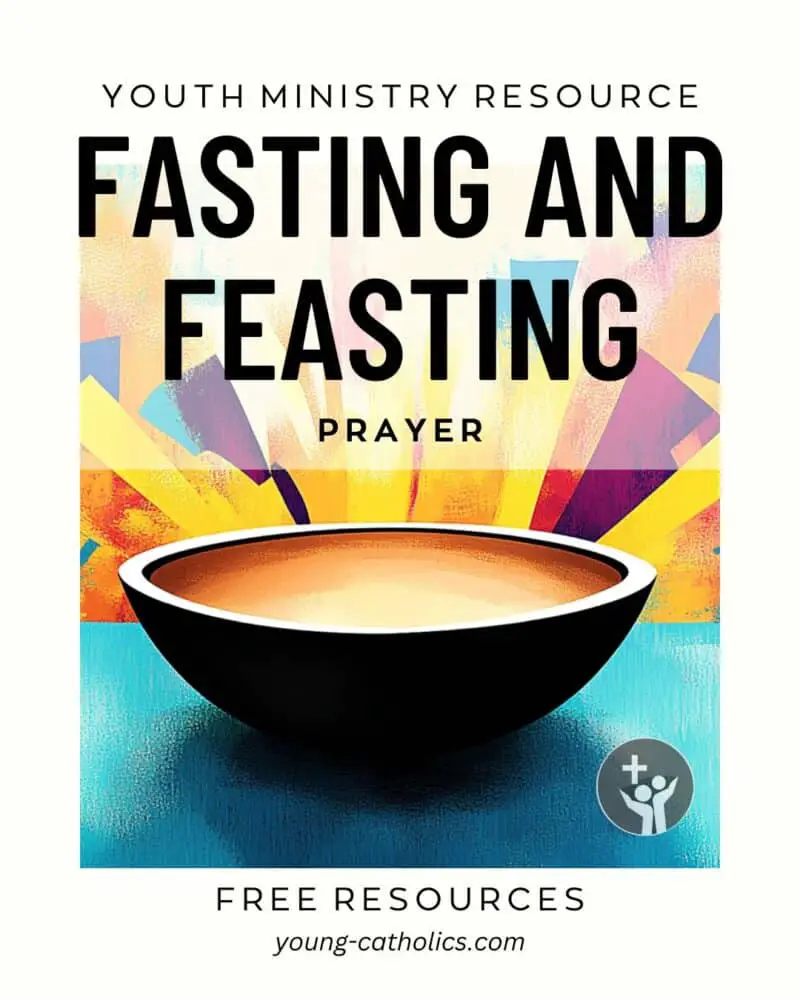Fasting Cup

Lent is a special time for Catholics. It lasts 40 days and helps us prepare for Easter. During Lent, we focus on three important things: prayer, fasting, and giving to others. These are the pillars of Lent. They help us grow closer to God and remember the sacrifice of Jesus.
Fasting is one of the most important parts of Lent. When we fast, we give something up as a way to say “no” to ourselves and “yes” to God. It helps us grow in self-control and think more about Jesus. Fasting is not just about food. It can mean giving up other things like TV, social media, or bad habits.
A great way to involve the whole family in fasting is by using a fasting cup. The fasting cup can make Lent more meaningful and fun for everyone. It is simple to set up and easy to use. Each person will get to fast in their own way, but you will be doing it together as a family.
This activity also helps children learn about the true meaning of Lent. By using the fasting cup, families can work together to live out their faith. It’s a way to grow in love for God and for each other.
Why Do We Fast? Understanding Its Purpose
Fasting is a spiritual practice that helps us focus on God. When we give something up, we make more room in our hearts for Him. Fasting is not just about skipping food or treats. It is about saying no to things that distract us so we can say yes to God.
Fasting reminds us of Jesus and His time in the desert. He fasted for 40 days and prayed to His Father. During that time, He trusted God and prepared for His mission. When we fast, we join Jesus in saying no to the things of the world and yes to the things of heaven.
Fasting also helps us grow closer to God. When we feel the sacrifice, we can turn to God for strength. This builds our trust in Him. It also makes us more thankful for His blessings. Fasting teaches us to depend on God and not on material things.
Using a fasting cup is a simple way to practice this as a family. The fasting cup helps each family member offer a daily sacrifice. These small acts of fasting can lead to big changes in our hearts. They help us focus on what matters most—our relationship with God.
Fasting and the Bible: Living God’s Word
The fasting cup can remind us of many stories in the Bible. One important story is when Jesus fasted for 40 days in the desert (Matthew 4:1-11). He gave up food and comforts to prepare for His mission. During this time, He trusted completely in God. When we use the fasting cup, we imitate Jesus by sacrificing something to grow closer to God.
The Bible also shows fasting as a way to seek God’s help. In the Book of Esther, Queen Esther fasted and prayed before asking the king to save her people (Esther 4:16). Her fast showed her trust in God’s power and her willingness to sacrifice for others. Using the fasting cup can remind us to pray and rely on God during difficult times.
Fasting also helps us remember that God provides everything we need. In Deuteronomy 8:3, Moses tells the people, “Man does not live by bread alone, but by every word that comes from the mouth of the Lord.” The fasting cup teaches us that we don’t rely on things like food, entertainment, or comfort. We rely on God.
The Catechism of the Catholic Church says that fasting “expresses conversion in relation to oneself, to God, and to others” (CCC 1434). Using the fasting cup connects us to these truths. It reminds us to turn away from distractions and turn our hearts toward God. Each sacrifice, no matter how small, is a way to live out the lessons of Scripture.
How to Create a Family Fasting Cup
Setting up a fasting cup is simple and fun. First, you will need a cup, jar, or any small container. Gather the family and talk about things everyone can fast from. Write each idea on a small piece of paper. Fold the papers and put them in the cup.
Think of simple things to fast from. Some examples are desserts, TV, video games, social media, or soda. You could also include things like complaining, arguing, or using unkind words. Choose items that everyone can give up for a day.
Place the fasting cup somewhere special. A family prayer table is a good spot. This reminds everyone that fasting is part of their prayer life. If you don’t have a prayer table, choose a visible place where the family gathers often.
Each morning during Lent, everyone picks a slip from the fasting cup. That will be their sacrifice for the day. Having the cup on the prayer table makes it easy to include this activity in family prayers. This way, fasting becomes part of your family’s daily Lent routine.
Making the Fasting Cup Part of Your Day
Each morning during Lent, gather as a family to use the fasting cup. Each person takes a turn picking one slip of paper from the cup. The paper they choose will tell them what to fast from that day. Everyone’s fasting choice may be different, and that’s okay.
If your family prefers, you can choose one item for everyone to fast from together. For example, the whole family might give up desserts or TV for the day. This is a great way to practice fasting as a team. It can also help you support each other in making the sacrifice.
Start the day with a prayer. Ask God for strength to stick with your fast. Reflect on why you are fasting. Think of how it brings you closer to God and reminds you of Jesus’ love. Prayer helps you keep a spiritual focus, even when the fast feels hard.
At the end of the day, you can return the slip to the fasting cup. Take time to thank God for helping you complete your fast. Reflect on how your sacrifice brought you closer to Him. Daily prayer and reflection make the fasting cup more meaningful for everyone.
Sharing or Keeping Your Fast Private
When using the fasting cup, each family member can decide whether to share what they are fasting from. Sharing can be helpful because it allows the family to support one another. For example, if someone is giving up arguing, others can encourage them to stay calm and patient.
Some family members might prefer to keep their fasting choice private. This is okay too. Fasting is a personal sacrifice between you and God. Keeping it private can make it feel even more special and meaningful. It reminds us that God sees what we do, even when others don’t.
Whether shared or private, using the fasting cup builds understanding in the family. If someone is struggling with their fast, others can show kindness and encouragement. This helps everyone grow in patience, love, and teamwork during Lent.
Respecting each person’s choice to share or not is important. It teaches that fasting is a personal act of faith but can also strengthen the family bond. The fasting cup is a simple way to help everyone grow in faith and love, together and individually.
Ending the Day with the Fasting Cup
At the end of the day, take time to reflect on the fasting cup and what it taught you. Gather as a family for a short discussion or spend a few moments alone in quiet reflection. Think about how the day’s fast helped you focus on God and grow in faith.
During family discussions, talk about any challenges you faced. Was it hard to give something up? Did you forget about the fast at times? Sharing these struggles can help everyone see that fasting isn’t always easy, but it is worth it.
Celebrate the successes too. Talk about moments when the fast reminded you of God or helped you grow. For example, giving up complaining might have led to more peaceful conversations. These small victories are signs of spiritual growth and love for God.
Remember that every sacrifice is an act of love. When we fast, we are showing God that He comes first in our lives. The fasting cup helps turn ordinary sacrifices into meaningful acts of faith. At the end of the day, thank God for giving you the strength to fast and for helping you grow closer to Him.
Reflection: Why Fasting Matters During Lent
Have you ever thought about why Catholics fast during Lent? It’s not just about giving up chocolate or soda because we have to. Fasting is about getting closer to God by giving something up that’s important to us. When you say no to yourself, you make space for God in your life.
Think about Jesus. He spent 40 days in the desert fasting and praying. He was tempted, but He stayed strong because He trusted God. When you fast, even in a small way, you’re following His example. It’s a way to remind yourself that you need God more than anything else.
Using a fasting cup is a simple way to fast. You pick something to give up for the day, like sweets or social media. It might not seem like a big deal at first, but it’s harder than you think! Every time you want to eat that candy or check your phone, you can stop and pray instead.
Fasting also helps you see the things that control you. Maybe it’s a habit like complaining or always needing to be on your phone. Fasting gives you a chance to break those habits and focus on what really matters—your relationship with God.
When you fast, you’re not just doing it for yourself. You’re offering that sacrifice to God. It’s a way of showing love for Him. And when it gets hard, you can ask Him for help. That’s what fasting is all about: trusting God and putting Him first.
This Lent, try using a fasting cup. Make it part of your day. See it as a way to grow in faith, not just a rule to follow. You might be surprised at how much you learn about yourself and your faith by doing this small act of sacrifice.
Prayer
Lord, help me to fast with a willing heart. Teach me to let go of the things I don’t need so I can focus more on You. Give me the strength to keep going when it’s hard. May my sacrifices be pleasing to You and bring me closer to You. Amen.
Reflection Questions
- What is one thing you can fast from that will help you focus on God?
- How can fasting help you see what controls your thoughts and actions?
- Why do you think Jesus fasted for 40 days in the desert?
- How can you use fasting as a way to grow in your faith?
Resources

Fast and Feast Prayer
The Fasting and Feasting Prayer is a meaningful way to live Lent. It focuses on replacing negative habits with positive ones. Instead of only giving something up, we fill the space with good things, like kindness, hope, and forgiveness.
Each line of the prayer helps us grow closer to God and others. It shows that Lent is not just about self-denial but also about spiritual growth and love. This prayer works well for personal reflection or group prayer. It can help make Lent a time of lasting change that brings peace and joy into our lives.

More Lenten Ideas for Prayer, Fasting, and Almsgiving
Lent is a season of prayer, fasting, and almsgiving. It begins on Ash Wednesday and lasts 40 days, reminding us of Jesus’ time in the desert. During Lent, Catholics make sacrifices, pray more, and give to others. We abstain from meat on Fridays, practice self-discipline, and reflect on our lives. It is also a time to go to reconciliation and grow closer to God.
Everyone, young and old, can join in these practices. Lent is about turning away from sin and focusing on God’s love. Use this time to deepen your faith and prepare for the joy of Easter.

Prayer, Fasting, and Almsgiving Video
Four Reasons for Fasting Video: Why should Christians fast? In this video, Fr. Mike Schmitz explains.
Fasting and Abstinence Information for Catholics
Ash Wednesday and Good Friday are obligatory days of fasting and abstinence for Catholics. In addition, Fridays during Lent are obligatory days of abstinence.
For members of the Latin Catholic Church, the norms on fasting are obligatory from age 18 until age 59. When fasting, a person is permitted to eat one full meal, as well as two smaller meals that together are not equal to a full meal. The norms concerning abstinence from meat are binding upon members of the Latin Catholic Church from age 14 onwards.
USCCB
Social Media Graphics and Bulletin Artwork
Slips of Sacrifice

Looking for a meaningful way to help families practice fasting during Lent? This image is available to download and use in your parish bulletin or newsletter. It pairs perfectly with an article on creating a family fasting cup.
Encourage families to grow in prayer and sacrifice together, one small choice at a time. Ideal for Lent-themed resources.
Paid subscribers may download a large copy this digital artwork without watermarks, suitable for use in bulletins, social media, newsletters, etc., free of charge by clicking here. You must be logged in as a paid subscriber to access the file.
Only current paid subscribers have the rights to use the artwork.
Questions and Answers
What is a fasting cup?
A fasting cup is a simple way for families to practice fasting during Lent. It is a cup or container filled with slips of paper. Each slip has an item to fast from written on it. Family members pick a slip each day to decide their fast.
How do we decide what to put in the fasting cup?
Talk as a family about things you can fast from. These could be desserts, social media, TV, arguing, or other habits. Pick items that are meaningful but not too hard for everyone to give up for a day.
Can young children use the fasting cup?
Yes, young children can participate. Choose simple fasts they can understand, like skipping candy or giving up their favorite show. The fasting cup can help teach them about Lent in a way they can enjoy.
Should we use the fasting cup every day of Lent?
You can use it every day or just on certain days, like Fridays. Lent is a time for prayer, fasting, and giving, so you can decide what works best for your family.
What if someone forgets about their fast during the day?
That’s okay. Lent is about trying and growing, not being perfect. Talk about it as a family, pray together, and try again the next day with the fasting cup.
Do we need to share what we’re fasting from?
No, it’s up to each person. Some people like to share, while others prefer to keep it private. The fasting cup works either way.
Where should we keep the fasting cup?
A good place is on a family prayer table or in another special spot. Keeping it somewhere visible helps remind everyone about the fast and makes it easy to use each day.
How does the fasting cup help with Lent?
The fasting cup makes fasting simple and meaningful for the whole family. It helps everyone focus on God, learn self-control, and grow in faith during Lent.
A Simple Way to Grow in Faith
The fasting cup is a meaningful and easy activity for Lent. It helps families practice fasting together in a way that fits their daily lives. The cup is filled with slips of paper, each listing an item to fast from. Every morning, each family member picks a slip and commits to fasting from that item for the day.
This activity connects to the Catholic tradition of fasting. It reminds us of Jesus’ 40 days in the desert and teaches us to rely on God. The fasting cup also makes fasting personal, while still involving the whole family in the Lenten journey.
Setting up a fasting cup is simple. Choose a cup or jar and fill it with ideas like desserts, social media, TV, or unkind words. Place the cup on a family prayer table or another special spot. Each day, reflect on the fast and thank God for His grace. The fasting cup turns everyday sacrifices into acts of love for God.
Your Turn
Make Lent more meaningful this year by creating a fasting cup for your family. It’s an easy way to grow closer to God while teaching children about sacrifice and faith.
Share your experience in the comments! Let others know what you included in your fasting cup and how it helped your family focus on God during Lent. Together, we can inspire one another on our Lenten journeys.

Leave a Reply